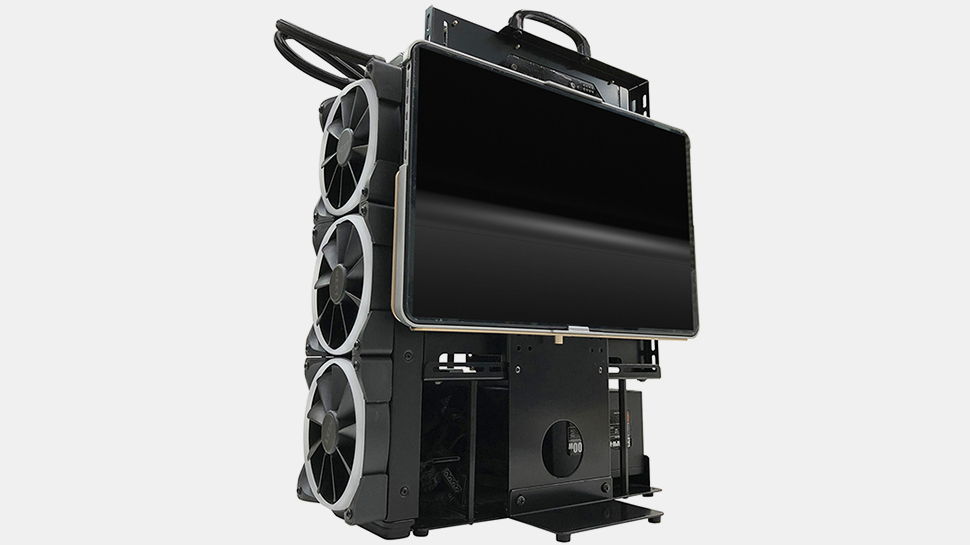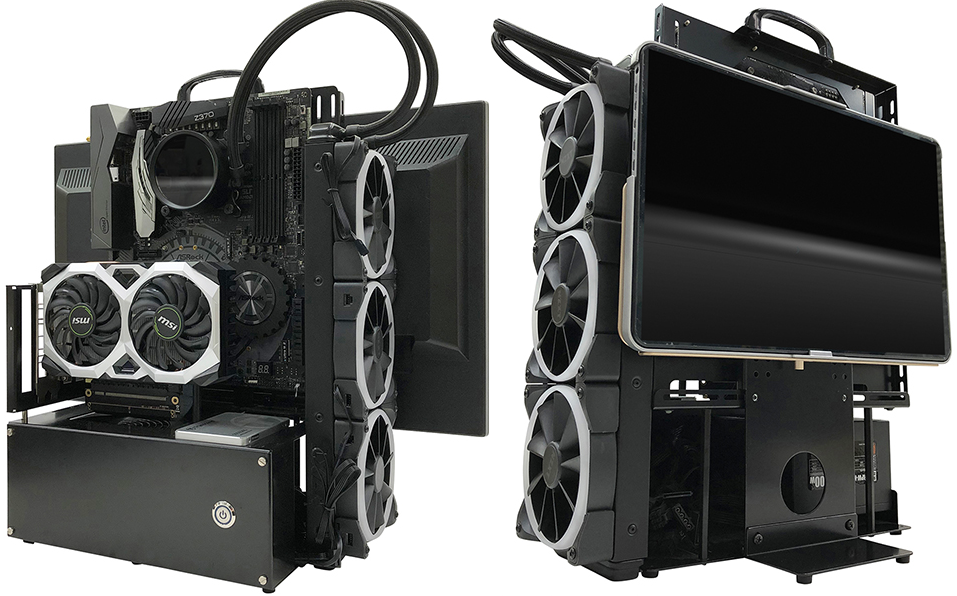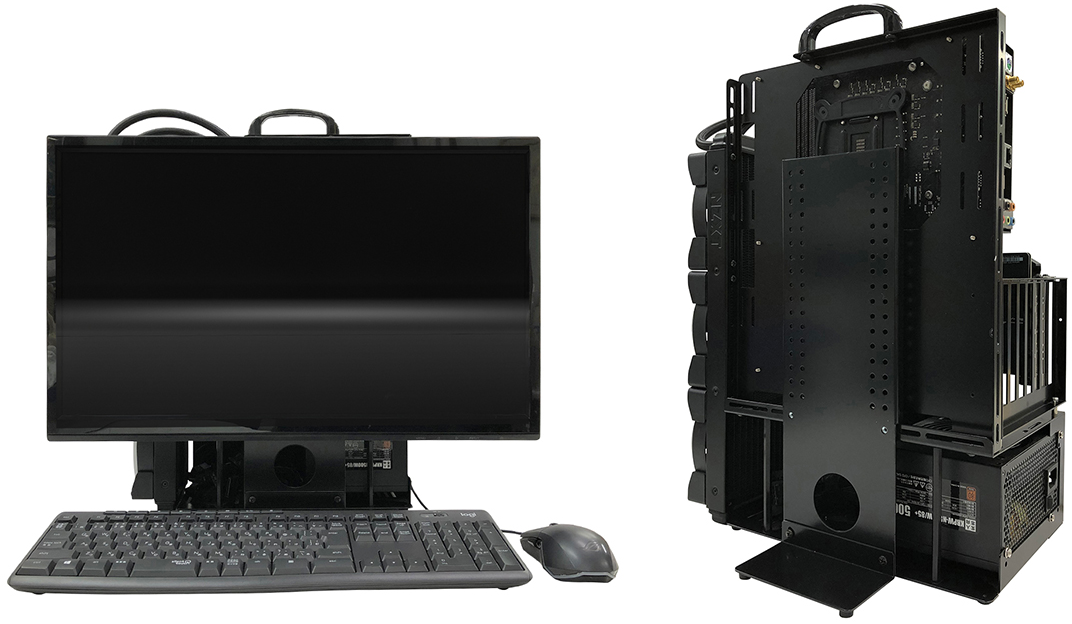Open Frame PC Case Launches with Monitor Mounting

We all want our PC rigs to look as clean as possible, but even the cleanest builds are not exactly straightforward regarding cable management and assembly. Furthermore, such machines are sometimes not easy to service. These are probably the thoughts of Nagao's engineers, who developed their N-Frame open-air chassis that combines simplicity, relative cleanness, serviceability, and even a mounting bracket for a display. It is the industry's first open-frame chassis for an all-in-one PC.
Nagao Seisakusho is an open-frame chassis specialist from Japan that has open-air chassis for various motherboard form factors and use cases. Nagao's latest development is its N-Frame-OP01 monitor mounting bracket (via momomo_us) that combines with one of its N-Frame open air chassis for ATX, Micro-ATX, Mini-ITX motherboards and essentially builds an open frame all-in-one PC. The monitor bracket has 75x75 and 100x100 VESA mounting holes, whereas the N-Frame PC chassis have a handle, which means that one can build a LAN party frag 'box' using Nagao's chassis.


Such a LAN party frag 'box' will probably not be the most compact. Still, it will undoubtedly look awe-inspiring, be easily serviceable, and have no airflow problems. In addition, the case will support all graphics cards regardless of their dimensions or how much heat they generate. Of course, graphics card compatibility will depend on the power supply used. Still, since it supports a variety of PSUs, the chassis can work with all graphics boards available today.
Another factor to consider is the weight balance between the system and the display, and this challenge might be pretty puzzling because you never know the exact weight of desktop components.
Products from Nagao are available from select retailers in Japan. Those interested in buying the company's open frame chassis can do it from Amazon.co.jp.
Get Tom's Hardware's best news and in-depth reviews, straight to your inbox.

Anton Shilov is a contributing writer at Tom’s Hardware. Over the past couple of decades, he has covered everything from CPUs and GPUs to supercomputers and from modern process technologies and latest fab tools to high-tech industry trends.
-
Sleepy_Hollowed This seems like a great case for benchmarks and testing, but I would not use this in a normal room where static can damage the life of components, so I don't know about LAN parties unless you got a lot of money to buy new computers on a regular.Reply
It does look great and seems great. -
Gam3r01 Reply
The dangers of ESD are greatly exaggerated these days, modern hardware is much more resilient than it used to be. Additionally, the case would be grounded just the same as any other metal case.Sleepy_Hollowed said:This seems like a great case for benchmarks and testing, but I would not use this in a normal room where static can damage the life of components, so I don't know about LAN parties unless you got a lot of money to buy new computers on a regular.
It does look great and seems great.
What I would be concerned about is damage to fans/ports by accidentally knocking into components or having stray objects lodge in them. -
Phaaze88 I like the look of this, though I do have a concern with regards to fans - or none at all.Reply
This puts them closer to the user than ever, so there's going to be an want to run fans at even lower rpms or opting for passive cooling. -
Marcus Dudek Maybe I'm wrong, but my main consideration would be dust, especially fatty dust layering on the hardware. Looks Nice though.Reply -
Sleepy_Hollowed Reply
It's quite the opposite, as processes get smaller, they get more succeptible to ESD damage unless they have a Mil-Spec for that specifically, which I doubt, unless the components cost like 5K each.Gam3r01 said:The dangers of ESD are greatly exaggerated these days, modern hardware is much more resilient than it used to be. Additionally, the case would be grounded just the same as any other metal case.
What I would be concerned about is damage to fans/ports by accidentally knocking into components or having stray objects lodge in them.
While you might get lucky with your components, I've actually seen damage done by ESD on boards and components, especially on dry rooms with carpets and on dry climate, which at the component level greatly reduce their lifetime, which is why I mentioned that if you're OK buying equipment on a regular, don't bother.
I don't have time at the moment to post some good studies on it, but if you have access to a research database, do some looking. Here's one:
https://terpconnect.umd.edu/~bthan/paper/IGBT/2019_IEEE%20TDMR_Test%20Scheme%20and%20Degradation%20Model.pdf -
Phaaze88 Reply
That should be EASY to deal with. Shut off completely, unplug, take 'er outside... go around it with a blower or one of those data vacs, and probably be done in a minute.Marcus Dudek said:Maybe I'm wrong, but my main consideration would be dust, especially fatty dust layering on the hardware. Looks Nice though. -
JWNoctis First thing that come to mind is the stray RF emission ruining the day of every ham and AM radio fan in the neighbourhood.Reply
Not that there are many of those left, sadly.
Gam3r01 said:The dangers of ESD are greatly exaggerated these days, modern hardware is much more resilient than it used to be. Additionally, the case would be grounded just the same as any other metal case.
What I would be concerned about is damage to fans/ports by accidentally knocking into components or having stray objects lodge in them.
All you need is a well-meaning relative with a duster, or a toddler with a handful of quarters and a screwdriver.
Or just a cat.
Probably not a good choice for anyone not living alone.